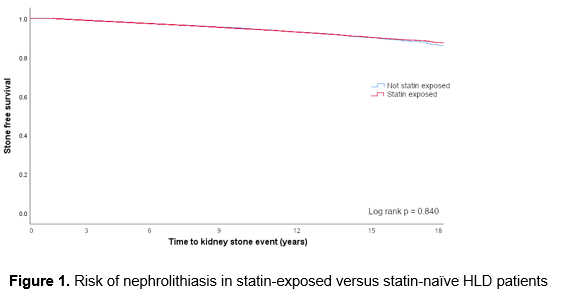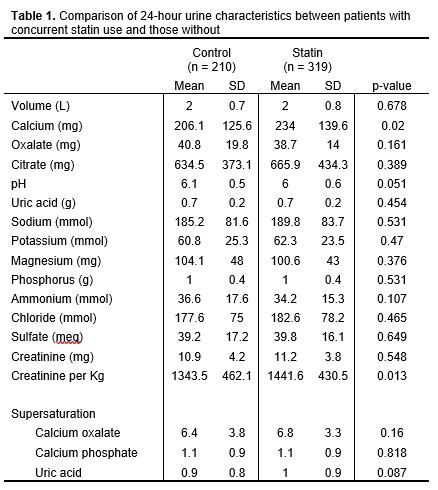Back
Poster, Podium & Video Sessions
Podium
PD50: Stone Disease: Epidemiology & Evaluation II
PD50-03: No association between statins and increased nephrolithiasis risk
Sunday, May 15, 2022
3:50 PM – 4:00 PM
Location: Room 255
Wilson Sui, Christina J. Peterson*, Naren Nimmagadda, Nicholas L Kavoussi, Nicole L Miller, S. Duke Herrell, Ryan S. Hsi, Nashville, TN
- CP
Podium Presenter(s)
Introduction: Recently studies have shown inconclusive evidence for the association of statin intake and risk of nephrolithiasis in large cohort studies, while the impact of statin use on urinary chemistry factors related to stone risk are unknown. Therefore, we sought to examine the association between statin use and incident kidney stone risk and evaluate statin use on 24-hour urine analysis.
Methods: We performed a single center, retrospective study of patients with the diagnosis of hyperlipidemia (HLD) and without a history of kidney stones across the electronic health record (EHR). Medication information on statin use was extracted and then the occurrence of an incident kidney stone diagnosis or procedure was identified. Kaplan-Meier analysis was used to estimate risk of incident kidney stone diagnoses. Then, among patients with HLD and kidney stones undergoing 24-hour urine metabolic testing, we compared 24-hour urine parameters with and without concurrent statin use.
Results: We identified n = 109,866 patients with HLD without prior medical therapy and without kidney stone history, of which 89,599 (81.6%) were exposed to statin over a median 6.5 years of follow-up. The statin exposed were more likely to have history of stroke, coronary artery disease, gout, hypertension, and diabetes. On survival analysis, statin use was not associated with improved stone-free survival (log rank p = 0.84). Among patients with 24-hour urine profiles (n=539), those with statin exposure had higher mean BMI, were more often male, and more likely to have a history of hypertension or coronary artery disease. Comparing 24-hour urine parameters, the statin-exposed had higher mean calcium (234 vs 206.1mg, p = 0.02), but there were no other differences in other analytes observed.
Conclusions: Contrary to prior studies, statin use does not appear to be associated with decreased risk of kidney stones. Additionally, there are no identifiable differences in urinary metabolites on 24-hour urine analysis that would suggest a benefit in reducing stone risk.
Source of Funding: The project described was supported by CTSA award No. UL1 TR002243 from the National Center for Advancing Translational Sciences. Its contents are solely the responsibility of the authors and do not necessarily represent official views of the National Center for Advancing Translational Sciences or the National Institutes of Health.


Methods: We performed a single center, retrospective study of patients with the diagnosis of hyperlipidemia (HLD) and without a history of kidney stones across the electronic health record (EHR). Medication information on statin use was extracted and then the occurrence of an incident kidney stone diagnosis or procedure was identified. Kaplan-Meier analysis was used to estimate risk of incident kidney stone diagnoses. Then, among patients with HLD and kidney stones undergoing 24-hour urine metabolic testing, we compared 24-hour urine parameters with and without concurrent statin use.
Results: We identified n = 109,866 patients with HLD without prior medical therapy and without kidney stone history, of which 89,599 (81.6%) were exposed to statin over a median 6.5 years of follow-up. The statin exposed were more likely to have history of stroke, coronary artery disease, gout, hypertension, and diabetes. On survival analysis, statin use was not associated with improved stone-free survival (log rank p = 0.84). Among patients with 24-hour urine profiles (n=539), those with statin exposure had higher mean BMI, were more often male, and more likely to have a history of hypertension or coronary artery disease. Comparing 24-hour urine parameters, the statin-exposed had higher mean calcium (234 vs 206.1mg, p = 0.02), but there were no other differences in other analytes observed.
Conclusions: Contrary to prior studies, statin use does not appear to be associated with decreased risk of kidney stones. Additionally, there are no identifiable differences in urinary metabolites on 24-hour urine analysis that would suggest a benefit in reducing stone risk.
Source of Funding: The project described was supported by CTSA award No. UL1 TR002243 from the National Center for Advancing Translational Sciences. Its contents are solely the responsibility of the authors and do not necessarily represent official views of the National Center for Advancing Translational Sciences or the National Institutes of Health.



.jpg)
.jpg)